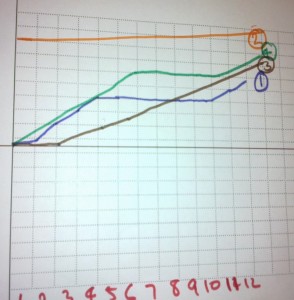Before I’d began the course, I’d already had some experience in making short films and had worked in the industry crewing on television commercials, so the prospect of having to use my own initiative, collaborate or work alone, was not daunting at all. Most of my creative practice
has been self-produced so self-learning was already well-established.Having said that, I did need help and I had to lean on the ‘digital natives’ in my class to help figure out this new fangled thing called ‘blogging’ (in my day we used to use ‘austromancy’ if we wanted to be heard).
Most of the time, the lectures were fascinating and helped me break down the rigid forms of my own thinking (e.g. semiotics, audience and technology vs culture), thus sparking seemingly random thoughts to enter my consciousness like, ‘Why haven’t they invented the Darth Vader vacuum cleaner, yet?’ or ‘Why do towels have so much power?’ or ‘Do snails cry?’ (Mmm. Perhaps semiotics is a bad for me…).
Anyway, I did struggle with the new terminology and concepts in the readings and it required me to think much deeper. But the good thing was I was able to adopt these theories into in my projects.
In terms of how I learn, I would say that most of the time I do it by trial and error, that it is by ‘doing’. I don’t mind being thrown in the deep end like when I had to interview and film at the same time for Project 4. This was difficult because I was roaming around the Melbourne Convention Centre, interviewing subjects while trying to keep them lined up in the viewfinder. Adding to this, I had to come up to speed with the latest version of iMovie (I’d just upgraded from my 2008 MacBook for this course) and re-learn how to edit (why they keep moving things around is beyond me!)
While I’m quite happy to figure out things for myself, I have found being in groups to be quite helpful particularly where someone shows you how to do something (if it’s not too complicated). Furthermore, groups are great for sparking ideas, seeking ways to improve your work, overcoming obstacles together and arriving at solutions quickly and effectively. This is why I liked the Practical Classes, despite my own sense of isolation of being much older than everyone else. It was when we were assigned collaborators that I finally felt I was able to share because we had the commonality of working on the same goal.
What does stand out for me the most about this course and that I hadn’t realised before is that I am a perfectionist when it comes to filming. I spent inordinate amount of time on The Whoniverse, crunching, tweaking it, showing it to friends for feedback, re-editing it because a frame didn’t have quite the right rhythm or the intonation in my voice over was not as good as I liked it to be (don’t get me started about how many times I re-recorded my voice!).
So, in the end, a rewarding semester and look forward to the studios next term.
Lastly, here is my Learning Graph. I couldn’t help but be reminded the film ‘Dead Poets Society where the students are asked to graph their understanding of poetry.

